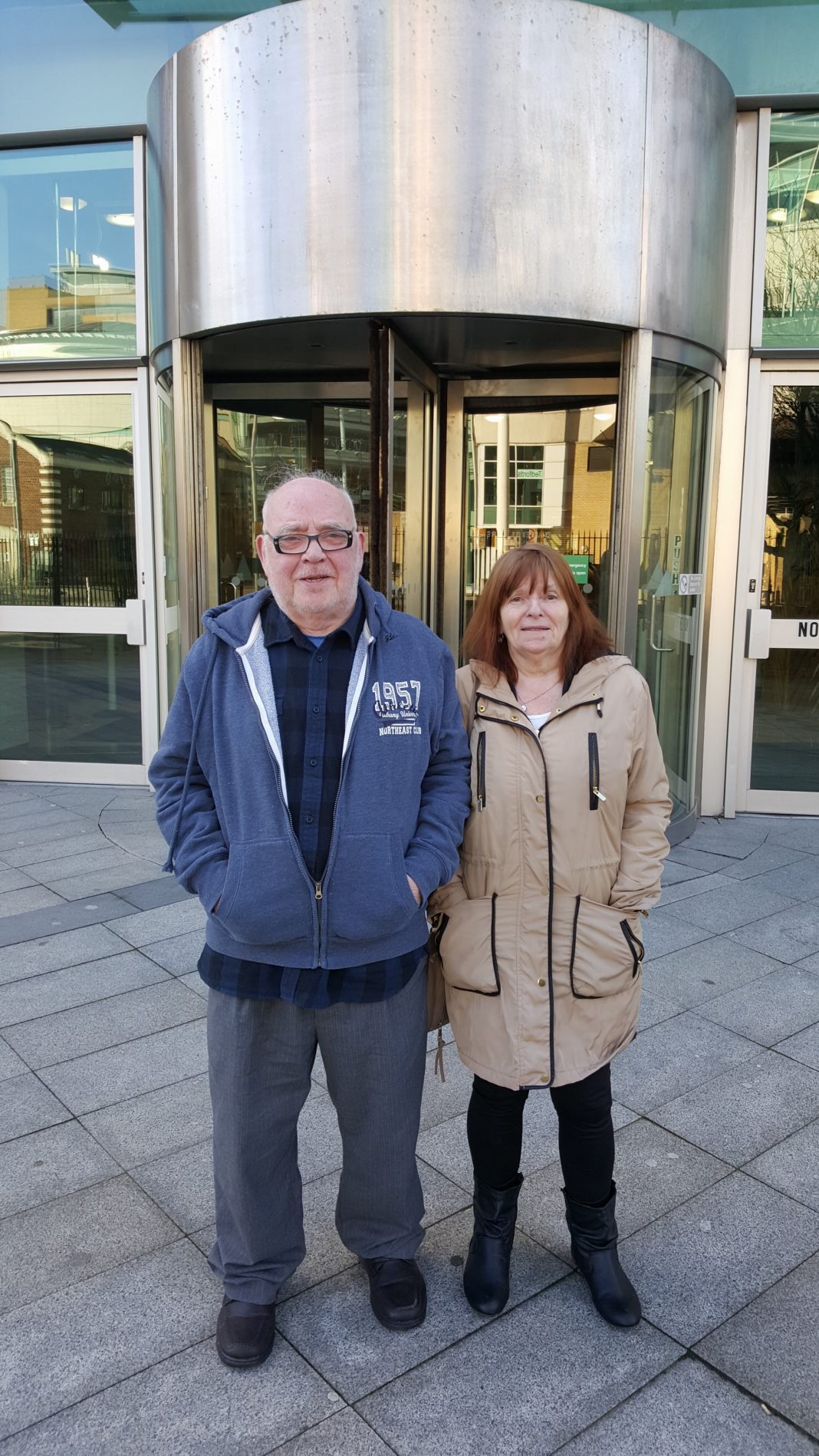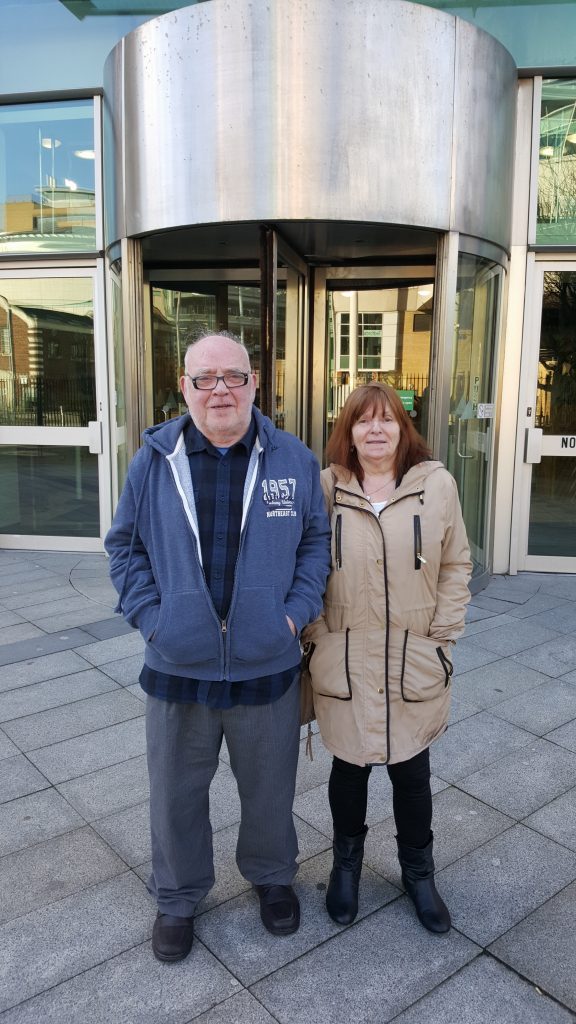This morning at the inquest of Pearse Jordan relatives of those affected by state violence were crammed up against ‘police tape’ in the public gallery of Courtroom 13 at Laganside Court. The section of the public gallery sealed off was to prevent the public from catching a glimpse of sergeant ‘A’ in the witness stand; a curtain was partially pulled to shield his identity.
They were there to express support and solidarity with the parents of IRA Volunteer Pearse Jordan, Hugh and Teresa, who have led a heroic 23-year legal battle seeking truth and accountability. Also attending were Sinn Féin MLA Pat Sheehan and colleagues Cllr. Janice Austin, Marie Cush and Jim Gibney.
‘A’ who killed Pearse Jordan sat facing Hugh and Teresa, who had won the right to see the witness as he gave evidence in the main body of the courtroom.
‘A’ was also in charge of the Headquarters Mobile Support Unit (HMSU) ‘operation’ on the ground that led to the killing and which was directed from a control room at RUC HQ and overseen by the joint RUC/British Army Task Coordinating Group (TCG).
And so we learned today that;
- There had been a continuous covert operation around a nearby property in Arizona St. off the Glen Rd. at which the IRA were being observed;
- ‘A’ and his team, in two cars, had been on standby all day and were instructed to intercept a car that had left Arizona St. at approximately 5pm;
- As this car passed the nearby Andersonstown/Glen Rd. junction they immediately left the RUC barracks that straddled that junction in pursuit;
- ‘A’ believed that the car Pearse Jordan was travelling in contained munitions (explosives, possibly a primed bomb, weapons);
- ‘A’, the front seat passenger in the lead RUC armoured car, claimed he just wanted to stop the car Pearse was driving and search it. He claims he instructed his driver to go alongside Pearse and that he attempted to wave Pearse down (this was rush hour traffic Peasre was actually going nowhere);
- He claims that Pearse looked at him and didn’t stop and that he then told the driver to ‘get him off the road’ and to ram him, which they did (asked would this be hazardous given what he believed to be in the car he replied no);
- ‘A’ then claimed to have exited his car superfast, (later saying this was due to the two cars impacting and breaking the door handle that enabled this), and that Pearse was already out of his car and running away towards the a second RUC car;
- ‘A’ claims that he shouted a warning ‘police halt or halt police’ he can’t recall. No witnesses, not even RUC witnesses, heard a warning;
- ‘A’ claims that Pearse then immediately ‘spun around’ to face him with his hands down posing what he claims to be a threat, even though he acknowledged Pearse was unarmed. He opened fire with his MP5 gun;
- Pearse Jordan was shot three times in the back – two bullets missed;
- It was put to ‘A’ that a story was concocted between officers who believed that Pearse had been shot in the front of the body. And that they had gotten their story wrong in the frenzy, confusing exit wounds with entry wounds. Medical evidence would later show that Pearse Jordan was shot in the back;
- ‘A’ denied he had concocted a story;
- It was further put to him that there were no logs on the day kept by either ‘A’, HMSU control or TCG, as would have been procedure, and that the only log recordings were from 5.03pm that day. In respect of even his own police notebook there was no detail. ‘A’ claimed that this lacked detail because he feared it ‘falling into the wrong hands’ – yeah like that of a judge came the whisper from one of the many relatives there to support the family;
- This, it was put, was because within minutes of the shooting Superintendent Bill Lowry, who would later head up RUC Special Branch, arrived on the scene and spoke to ‘A’ and that the RUC then gave a briefing to the media claiming that they had shot a senior member of the IRA when in fact that briefing named a different person altogether;
- It was also put to ‘A’ that news reports in the following days, namely the Newsletter, claimed that the RUC operation was ‘botched’ and that they had got the ‘wrong man’;
- ‘A’ claims that he never ever read any articles and like previous RUC witnesses none of them read these newspapers – strange that when it’s the main paper that supported the RUC and to which they briefed;
- It was again put to him that the actual intention was to shoot another person and that ‘A’ was hyped up and they got the wrong person hence the missing logs referencing the covert op on this person. This was the reason why stories were concocted and logs either tampered with or destroyed and again ‘A’ refuted this;
- It was then put to ‘A’ that he had previously perverted the course of justice, concealed evidence, and obstructed police officers in 1982 in relation to what has become known as shoot-to-kill and that (by the then British Attorney General, Sir Patrick Mayhew) it had been determined that it wasn’t in the public interest to prosecute him and others involved – ‘A’ agreed that he had done so;
- It was also put to ‘A’ that he described himself in previous evidence as ‘the most experienced and effective anti-terror firearms officer in Europe’ to which he agreed that at the time of the shooting he was;
- He also acknowledged that rules governing the use of firearms were written in an office and not for on the ground;
- He also acknowledged that he provided expert training in firearms to specialist units of the RUC engaged in protection duties etc.;
- He also accepted that he was specially trained to deal with such situations and that this training was to determine threats within split seconds and that he was the most experienced;
- And so it was put to him that in the circumstances his story of what happened was untrue – he could have easily determined that Pearse posed no threat whatsoever – but the intention was to kill someone else – Sgt A disagreed;
- How could Pearse Jordan have run in the direction ‘A’ claims, towards the second RUC car, then spin to turn to face him, ‘A’ fires and as he fires Pearse then turns away again as the bullets leave his gun at over 800 MPH, faster than the speed of sound, and from approximately 5/6 yards away, to be then shot in the back;
- It was also put to ‘A’ that a covert soldier in another car had an unobstructed view of Pearse in a completely different position being shot in the back in the middle of the road – ‘A’ disagreed;
- ‘A’ also claimed that whilst he exited his car, in the rush, he accidentally switched his gun from single shot to automatic which accounted for the burst of fire – a common excuse for excessive force in many state killings. ’A’ claimed his MP5 had a mechanical fault with the switch due to its constant use;
- It was put to ‘A’ that he acted under the old RUC rules of ‘back in day of the shoot-to-kill’ with speed, firepower, and aggression contrary to the rules of 1992
- Counsel for the Jordan family said, “rules that you gave training on and that focused on the need to justify the use of force – rules that you knew all about and that you chose to ignore. I put it to you, that you lied in 1982 and again you lied in killing Pearse Jordan”;
With a similar MP5 gun Sergeant ‘A’ demonstrated to the court, those who could see him including Hugh and Teresa, how he handled and pointed his weapon as he shot Pearse. It must have been chilling for them but their dignity in the face of this was demonstrated in not showing their emotion. Their determination not to let their son down was once again demonstrated.
Today was more a case of spinning tales than Pearse Jordan spinning around or posing a threat. It was about ‘A’ trying to cover his tracks but his evidence story was as well worn as the switch on his gun and we’ve heard such lies all too often. It’s time for justice.
His evidence was given with an attitude all too pervasive within the RUC and the PSNI still, an attitude of “so what”! The Bill Lowry-esque attitude of open hatred and hostility for republicans was summed up in Sergeant A’s evidence when he said he ‘had no regrets for killing Pearse Jordan’ and that his only regret was that there was a ceasefire and that he didn’t get any more action.
A big question outside of this is – why are the PSNI permitted to defend the indefensible and continue the impunity, spending millions to do so?












